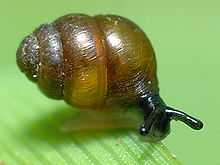Vertigo (gastropod)
| Vertigo | |
|---|---|
 | |
| A live individual of Vertigo moulinsiana | |
| Scientific classification | |
| Kingdom: | Animalia |
| Phylum: | Mollusca |
| Class: | Gastropoda |
| (unranked): | clade Heterobranchia clade Euthyneura |
| Superfamily: | Pupilloidea |
| Family: | Vertiginidae |
| Subfamily: | Vertigininae |
| Tribe: | Vertiginini |
| Genus: | Vertigo O. F. Müller, 1773[1] |
Vertigo is a genus of minute, air-breathing land snails, terrestrial pulmonate gastropod molluscs or micromollusks in the family Vertiginidae, the whorl snails.
Distribution
The distribution of the genus Vertigo includes Europe, northern Asia, eastern Asia, Japan, Central and North America, Caribbean and the Bermudas.[2]
Shell description
In this genus, the shell is deeply rimate and ovate. The apex is acuminate and obtuse. The shell has 5-6 whorls. The last whorl is rounded. The aperture is semioval with 4 to 7 folds. The peristome is scarcely expanded and white-lipped.[3]
Anatomy
Snails in the genus Vertigo have no oral tentacles, thus they have only one pair of tentacles.
The jaw is arched; the ends squarely truncated; the anterior surface striate; the cutting edge with a median projection. The radula has a central tooth that is almost square, tricuspid, as large as or larger than the lateral teeth, which are similar, narrower, and bi- or tricuspid. The marginal teeth are low, wide and serrated.[3]
Species

Species in the genus Vertigo include:
subgenus Vertigo O. F. Müller, 1774
- Vertigo alpestris Alder, 1838 - tundra vertigo
- Vertigo antivertigo (Draparnaud, 1801)
- Vertigo arctica (Wallenberg, 1858)
- Vertigo arthuri Von Martens, 1882
- Vertigo bollesiana (Morse, 1865) - Delicate vertigo snail
- Vertigo botanicorum Horsak & Pokryszko, 2010[4]
- Vertigo extima (Westerlund, 1877)
- Vertigo genesii (Gredler, 1856) - Round-mouthed Whorl Snail
- Vertigo geyeri Lindholm, 1925
- Vertigo gouldii (Binney, 1843)[5]
- Vertigo heldi Clessin, 1877
- Vertigo lilljeborgi (Westerlund, 1871)
- Vertigo milium (Gould, 1840)[5] - Blade Vertigo
- Vertigo modesta (Say, 1824) - cross vertigo
- Vertigo moulinsiana (Dupuy, 1849) - Desmoulin's whorl snail
- Vertigo ovata (Say, 1822)[5] - ovate vertigo
- Vertigo paradoxa Sterki in Pilsbry, 1900
- Vertigo pseudosubstriata Ložek, 1954[6]
- Vertigo pusilla O. F. Müller, 1774 - type species
- Vertigo pygmaea (Draparnaud, 1801) - crested vertigo
- Vertigo ronnebyensis (Westerlund, 1871)
- Vertigo substriata (Jeffreys, 1833)
- Vertigo ventricosa (E. S. Morse, 1865)
subgenus Vertilla Moquin-Tandon, 1856
- Vertigo angustior Jeffreys, 1830 - Narrow-mouthed Whorl Snail
subgenus ?
- Vertigo alabamensis G. Clapp, 1915 - Alabama Vertigo
- Vertigo conecuhensis G. Clapp, 1915
- Vertigo cubana Crosse, 1890[5]
- Vertigo eogea
- Vertigo eogea stagnalis
- Vertigo hachijoensis
- Vertigo hebardi Vanetta, 1912
- Vertigo hirasei
- Vertigo hubrichti Pilsbry, 1934
- Vertigo japonica
- Vertigo kushiroensis
- Vertigo meramecensis Van Devender, 1979
- Vertigo neglecta Arango in Poey, 1856[5]
- Vertigo oralis Sterki, 1890 - Palmetto Vertigo
- Vertigo oscariana Sterki, 1890 - Capital Vertigo
- Vertigo occulta Vanetta, 1912
- Vertigo parcedentata (Braun, 1847)
- Vertigo rugosula Sterki, 1890 - Striate Vertigo
- Vertigo teskeyae Hubricht, 1961 - Swamp Vertigo
- Vertigo torrei Aguayo & Jaume, 1934[5]
- Vertigo ultimathule Proschwitz, 2007[7]
References
This article incorporates public domain text from reference.[3]
- ↑ Müller O. F. 1773. Vermivm terrestrium et fluviatilium, seu animalium infusoriorum, helminthicorum et testaceorum, non marinorum, succincta historia. Voluminis Imi pars Ima. pp. [1-33], 1-135. Havniæ & Lipsiæ. (Heineck & Faber).
- ↑ "Genus summary for Vertigo"]. AnimalBase, last modified 30 January 2010, accessed 2 October 2010.
- ↑ 3.0 3.1 3.2 Baker F. C. (25 April) 1902. The Mollusca of the Chicago Area. Part II. Gastropoda. Bulletin No. III. of the Natural History Survey, The Chicago Academy of Sciences, 418 pp. 33 plates, page 240-241.
- ↑ Horsak, M. & Pokryszko, B. M. "Vertigo botanicorum sp. nov. (Gastropoda: Pulmonata: Vertiginidae)–a new whorl-snail from the Russian Altai Mountains." Zootaxa 2634 (2010): 57-62.
- ↑ 5.0 5.1 5.2 5.3 5.4 5.5 "Mollusca". Diversidad Biológica Cubana, accessed 23 March 2011.
- ↑ (German) Ložek V. (1964). Quartärmollusken der Tschechoslowakei. – Rozpravy Ústředního ústavu geologického, Praha, 31: 374 pp., pages 204-205.
- ↑ Proschwitz T. von (2007). "Vertigo ultimathule n. sp., a new whorl-snail from northernmost Sweden (Gastropoda: Pulmonata: Vertiginidae)". Heldia 5(3): 73-74, Taf. 9. München.
Further reading
- Speight M. C. D., Moorkens E. A. & Falkner G. (2003). Proceedings of the workshop on conservation biology of European Vertigo species.
- Myzyk S. (2005). "Egg structure of some vertiginid species (Gastropoda: Pulmonata: Vertiginidae)". Folia Malacologica 13: 169. (open access with registration required)
External links
| Wikimedia Commons has media related to Vertigo (genus). |
- Vertigo at National Center for Biotechnology Information (NCBI)
- gallery of selected Vertigo species
- http://www.biolib.cz/en/taxon/id2689